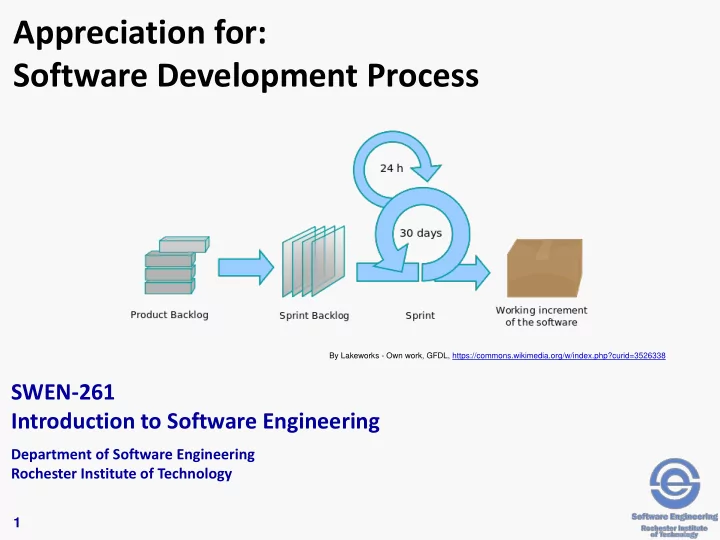

Appreciation for: Software Development Process By Lakeworks - Own work, GFDL, https://commons.wikimedia.org/w/index.php?curid=3526338 SWEN-261 Introduction to Software Engineering Department of Software Engineering Rochester Institute of Technology 1
What do you want in a Software Development Process? A few questions to consider: How does a software development process provide value to the customer? How does a software development process support a team to be predictable and dependable? How does a software development process improve software quality? 2
These are the principles software engineers follow. Customer-focused • A customer representative must be on "the team" • The customer validates each increment • The customer defines and prioritizes the requirements Use an iterative process • Build a working increment frequently • Demo the increment to the customer and get feedback Manage risk • Involve the customer to validate and elaborate requirements • Work on architecturally-significant features early Use an empirical process • Process is transparent to all stakeholders • The team inspects their own process each iteration • The team adjusts their process from lessons learned in the previous iteration 3
These are the core activities software engineers practice. Communicate • Gather requirements to understand the customers needs and goals. • Demonstrate each project increment for the customer. Plan • Plan each iteration (sprint) of work so the stakeholders know what is expected. • Conduct retrospectives to improve the process. Model • Analyze the domain of the application for a deeper understanding of the requirements. • Design the system to meet the requirements. Construct • Implement a working increment within each iteration. • Test the system to validate that it meets the requirements. • Maintain the system by fixing bugs and creating new features. Deploy • Deploy software to the production environment. • Train users so they will succeed with the system. 4
A defined process codifies the way in which a team will adhere to those principles and practices. • Traditional waterfall • Spiral methodology • Feature-driven development • Rapid Application Development • Extreme programming • Rational Unified Process • OpenUP 5
OpenUP describes project phases at the strategic level. By The original uploader was GFLewis at English Wikipedia - Transferred Inception from en.wikipedia to Commons by IngerAlHaosului using CommonsHelper., EPL, https://commons.wikimedia.org/w/index.php?curid=9030478 • Manage requirements risks Elaboration • Manage architectural risks Construction • Build it out Transition • Deploy it • Training users 6
A team's effort in different activity areas varies by phase. By Dutchguilder - Own work, Public Domain, https://commons.wikimedia.org/w/index.php?curid=37249677 7
You will use a Scrum process to define tactical activities. By Lakeworks - Own work, GFDL, https://commons.wikimedia.org/w/index.php?curid=3526338 A Sprint is a single iteration of work that results in a working system that delivers identified value to the customer. Each Sprint has its own Sprint Backlog of features pulled from the Product Backlog. Every day the team is working the Sprint Backlog to direct their development. 8
Now you can take the quiz on Appreciation for software development process. 9
Recommend
More recommend